|
A textile artist takes his show on
the road
ADA: Arts for All
ORBI to sponsor May ADA workshop
From the Director
Artist Fellowship winners
announced
MAAF update
Reading Quilts
Strictly business
Are children being left behind?
Griffin wins national award
First Day
Bringing writers together
WV Writers annual conference
|
A textile artist takes his show on the road
Story and photographs by Colleen Anderson
Elkins textile artist Michael Davis usually spends his workdays
in a garage studio, often up to his elbows in dye. In November
2002, however, his shibori-dyed wearable art took him to London and
North Yorkshire. Better yet, most of it stayed in London — on
the racks of a high-end boutique — when he came home.
Davis began dyeing garments in 1969, but was introduced to
shibori dyeing in 1981 by Yoshiko I. Wada. Wada is a diminutive
Japanese-American woman whose dye work, books, teaching and
promotion of shibori have earned her a reputation as the
world’s leading authority on the art.
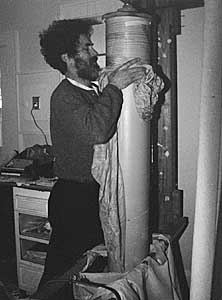
Davis in his studio, using a machine he
invented to speed his work. |
The Japanese word “shibori” covers a
multitude of dye techniques. Wada’s preferred translation is
“shaped resist dyeing,” which describes the process of
creating pattern by manipulating a two-dimensional cloth surface
into a three-dimensional shape before compressing it to dye. The
fabric may undergo plucking, pinching, bunching, pleating, folding,
wrapping, stitching, tying, clamping or a combination of these. The
resulting pattern may be orderly or random. Some shibori techniques
are centuries old; others are being invented by a new worldwide
community of artists, many of them Wada’s students.
Davis, whom Wada classifies as one of a group of
“master dyers” she has taught, was one of 20 artists
she selected for a London trunk show that included work from
Australia, Canada, Chile, India, Japan, Switzerland, the United
Kingdom and the U.S. Much of the work Davis displayed at the show
featured piecework and construction by Carol Freeman, with whom he
collaborates on a line of kimonos, tunics, jackets and scarves.
|
Joss Graham Oriental Textiles, located near London’s
Victoria Station, occupies several rooms and smells of incense and
old fabric. A day before he show, it buzzed with activity as
several assistants hauled out merchandise from a previous show and
began arranging the works of shibori artists. Shibori shared the
space with antique textiles, brass and stone sculptures, baskets
and woodworks. Every wall, every nook, every surface —
including ceilings and staircase railings — served as display
space. Arriving artists waited for a turn at a rickety ironing
board, admired each another’s work and surreptitiously
compared prices.
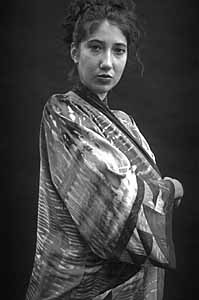
Zaia Wharton models a Shibori West kimono.
Textile dyeing by Michael Davis, piecework and garment construction
by Carol Freeman |
The five-day trunk show included an invitation-only
preview, a “sushi and shopping” evening and a closing
reception. Artists talked to customers and, with equal enthusiasm,
to one another. Most planned to go on to the fourth international
shibori symposium in North Yorkshire when the trunk show ended.
There was time to be a tourist, too —
climbing to the top of St. Paul’s Cathedral to get a great
view of London, walking across the new Millennium Bridge, even a
day trip to the village of Downe to visit Charles Darwin’s
home and drink a pint of “Old Speckled Hen” at the
George & Dragon Pub.
But, for Davis, the most exciting event was a
meeting with the owner of an exclusive shop in Knightsbridge, which
resulted in the sale of almost all the inventory he had brought
with him — and a new international outlet for his textile
business, Shibori West.
After a week in London, Davis made his way to
Harrogate, North Yorkshire to attend the symposium, which was
planned to coincide with a huge annual knitting and stitchery show.
(Symposia have also been held in Japan, India and Chile in 1992,
1997 and 1999, respectively.)
|
|
Harrogate is an old spa town. Its century-old
Turkish baths remain a popular attraction, but the town’s
economic mainstay nowadays is a gigantic conference center and the
hundreds of upscale shops and restaurants surrounding it.
In late November, three enormous exhibit halls were
filled to capacity with stitchery supply vendors, stitchery artists
and gallery-style exhibitions from as far away as South Africa.
Thousands of people, mostly female, had come to Harrogate for this
annual show. Frail, blue-haired ladies clutching needlepoint hoops
rubbed shoulders with magenta-haired students from nearby Leeds
College of Art and Design. Alongside traditional needlecrafts were
contemporary works that stretched the boundaries of
“stitchery,” including quilts that employed plaster,
paint, leather, beads, safety pins, wood screws, nylon netting and
cheesecloth.
|
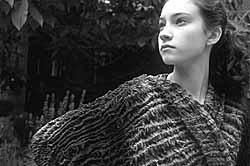 Erin Webb models a Shibori West jacket in
which the puckered shaping of the fabric remains an integral part
of the finished product.
Erin Webb models a Shibori West jacket in
which the puckered shaping of the fabric remains an integral part
of the finished product. |
As part of the extravaganza, the World Shibori Network (WSN)
occupied one corner of an exhibition hall, and shibori banners
decorated the entrance foyer. The WSN also sponsored a gala evening
fashion show.
While stitchery fans streamed through the exhibit halls, the
shibori symposium proceeded in an adjacent building. The two-day
conference featured a brisk schedule of lectures and
demonstrations.
In one presentation, Yukiko Echigo led her audience through a
paper-folding session to illustrate her “origami stitched
shibori” process. She uses paper models and scissors to work
out the elaborate patterns she creates. After folding a sheet of
cloth like paper, she stitches a pattern into the folded layers,
dips the folded and stitched fabric into dye, then uses a chopstick
to open up the fabric to water. Water oxidizes the indigo dye,
creating soft gradations from dark blue to white. To achieve her
complex designs, she may open, fold, stitch and dip a single piece
as many as 30 times.
A detail from "Waving,"
an indigo-dyed cotton banner by Kikuko Matsui.
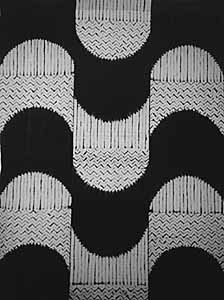
|
Mie Iwatsubo demonstrated how she combines shibori with felting
and knitting to create her nature-inspired bags, scarves and hats.
She said she knew that shibori was her calling from the moment she
discovered it: “I was instantly engaged. I saw that I should
do this, and I should tell everybody that shibori is
beautiful.”
Davis experienced a similar epiphany in 1981, on the night
before his first workshop with Yoshiko Wada (in Gatlinburg, TN).
“It was dark when I arrived. I walked through a building
where they had a shibori exhibit, and saw a small, framed piece of
arashi shibori by Ana Lisa Hedstrom. I was knocked off my feet by
the beauty and intricacy of this small piece of fabric. It was like
snakeskin or mushroom gills or butterfly wings that wanted to take
flight.”
Wada’s workshop confirmed that arashi shibori, in which
fabric is wrapped around a pole before being tied and dyed, was
what he wanted to do. “I came home and changed everything. As
soon as I started doing arashi shibori,” he said, “we
began getting into the better craft shows, and the wholesale
business started growing.”
Davis and Laurie Gundersen, his wife and business partner for
many years, converted a former goat shed into a textile studio with
heat, skylights, hot and cold water, cutting table, double sink,
stove, sewing machine and storage space. Gundersen developed
garment patterns, and Davis built a machine to speed the wrapping
process.
In 1992, one of his textured jackets was accepted into a
prestigious biennial textile competition in Kyoto. Later the same
year, with help from a West Virginia Commission on the Arts
Professional Development grant, Davis returned to Japan, this time
with Gundersen, to attend the first international shibori
symposium. In 1994 they received a $2,500 fellowship from the
Commission on the Arts. Although Davis and Gundersen no longer work
to gether, both continue to explore shibori techniques.
|
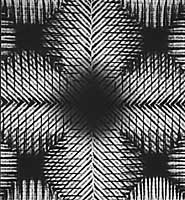 A detail from "Flower and Bud," an
indigo-dyed cotton banner by Hiromi Sera.
A detail from "Flower and Bud," an
indigo-dyed cotton banner by Hiromi Sera. |
Davis formed Shibori West in the mid-1990s. In addition to
producing wearable art, he has developed several sculptural lamp
designs.
According to Davis, the trip to England was valuable for several
reasons. “Yoshiko Wada’s recognition and encouragement
means so much,” he said. “It inspires me to keep
growing as an artist. And the communication with other artists is
important; when that sort of sharing takes place, everyone
benefits.”
And there’s that shop in Knightsbridge. Davis hopes they
will need a new shipment of wearable art before long. “Who
knows?” he mused. “Maybe I could deliver it in
person.”
More of Davis’s work is on view at his website:
www.shiboriwest.com. To contact writer Colleen Anderson, e-mail her
at [email protected].
More about shibori
For his wearable art, Michael Davis uses a relatively modern
technique, arashi shibori, which was invented in the late 19th
century in the Japanese town of Arimatsu. It involves wrapping
cloth around a pole, tying, compressing and dyeing. The resulting
patterns often suggest rain driven by a strong wind
(“arashi” means “storm”). A piece of fabric
may undergo this four-part process once or several times, depending
upon the pattern the artist wants to achieve. In arashi shibori,
the texture may become part of the finished surface and contribute
to the sculptural qualities of the art.
|
There are many other shibori techniques, some very
ancient. The earliest known examples of the art include silk found
in 4th-century Chinese tombs and pre-Columbian shibori alpaca in
Peru. Shibori traditions have existed for centuries in the Middle
East and in the Indian subcontinent as well as in Asia. Active
production continues in western Africa, in southern China and in
the western regions of India. Northern Africa, the Middle East,
Indonesia and the Himalayan region are also active to a lesser
degree. In the past 25 years, Western interest in shibori has
mushroomed.
Materials and methods found in different traditions
vary widely. Furthermore, an artist may dye a piece of cloth
repeatedly, using a different shaping method each time. There
really are no limits to the creative possibilities of shibori.
|
|
An excellent introduction to the history of shibori dyeing is
Yoshiko I. Wada’s first book, Shibori, originally published
in 1983 and issued in paperback in 1999 by Kodansha International.
Her second book, Memory on Cloth: Shibori Now (2002), is equally
informative. Both books also illustrate techniques and showcase the
work of leading contemporary shibori artists.
The World Shibori Network was organized to encourage the study
and practice of shibori crafts in the world. For more information
about shibori or the organization, visit the group’s website
at www.shibori.org.
|

